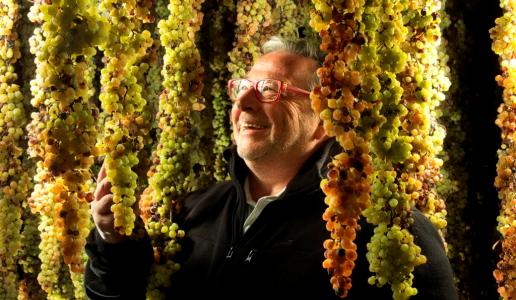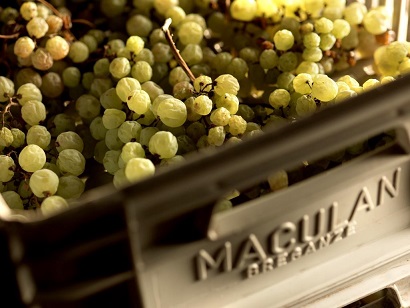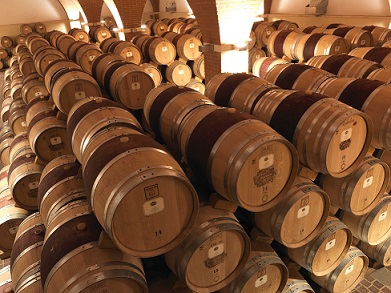Acininobili Maculan, a predisposition for sweet wines (1)

Acininobili is a botrytized wine that Fausto Maculan produces from raisinated Vespaiola grapes that are typically found in the area of Breganze in the Colli Vicentini hills.
Squeezed between the incredible success of Prosecco to the east and the majestic and always stronger area of Valpolicella, the province of Vicenza remains one of the best-kept secrets in the winemaking region of Veneto. It is a microcosm situated between the Colli Berici and the Alpine foothills that has an exceptionally favorable microclimate that allows for the production of all kinds of wines: from the delicate and dry white wine Gambellara, which is similar to Soave; to the vibrant, German-style Breganze Vespaiolo; from the fragrant and super-fruity red – a kind of Veneto Beaujolais – Tai Rosso to ambitious reds made from Bordeaux varietals

The town of Breganze has always been considered a point of reference within this microcosm. Located at the feet of the Asiago plateau, near the foothills, Breganze is at the center of a DOC appellation that included several villages spread across a 30km stretch that runs east to west. The area can be ideally divided into two sectors: the hills of volcanic origin and the plains which are clearly alluvial in origin, with many gravelly zones that spread out rainwater. The best vineyards are on the hills where some have a soil with more of less crumbly basalt while others have a reddish soil indicating ferrous residue. All the soils, however, are light and thin which do not allow the plants to become too vigorous.
And it is here that Acininobili is born, the name a clear reference to Alsace and the Sélection de Grains Nobles to underscore the wine’s DNA, being made with botrytized or noble rot grapes. The showcase wine of the Maculan winery, Acininobili was created in the 1980s by Fausto Maculan, who is the estate’s founder and driving force. It is a unique wine starting with its ampleographic base, made with only Vespaiola grapes. “To tell the truth, we also tried to make a botrytized wine using Sémillon and Sauvignon but after a few attempts we dropped the idea and preferred to continue using Vespaiola. Nevertheless, our model has always been Chateau d’Yquem,” Fausto Maculan confessed to me.
Vespaiola is an indigenous, white wine grape that is only found in the province of Vicenza. It was traditionally planted with a very low density and the vines were double-arched, cane-trained sometimes using four arches. This produced a very high yield of grapes per vine. Maculan, on the other hand, planted his vineyards to have a density of up to 5,000 vines per hectare that are guyot-trained to allow the vine to become more vigorous and produce grapes with a higher sugar content in thin bunches. The varietal has quite a long growing cycle and the grapes reach perfect maturity usually around the middle of September in small, cylindrical cone-shaped bunches and a very pronounced wing.

Vespaiola and acidity: when ripe, the average amount of tartaric acid is 7-7.5g/l, a couple of points above the norm for white grapes, which is 5-5.5g/l. Thus acidity is a distinct trait of all wines made from Vespaiola be they white or sweet. The thinnest bunches are harvested first and put on racks to raisinate. The bunches that are more compact are used to make a white wine can be quite interesting. The aromatic potential of the grapes must be protected from the start from oxidation using dry ice or liquid nitrogen during pressing. Several days of cold maceration on the skins before fermentation creates aromas that become extraordinary in the glass.
Drying the grapes traditionally took place in the grain silos of farmers who tied the bunches onto string and hung them from the ceiling with ventilation, essential for drying, ensured by open windows. Today, the healthy grapes are brought to the winery in small crates where they dry up to the middle of January. Once they have lost half their weight and more than doubled their sugar content the grapes are pressed. The must then ferments in stainless steel vats where it is monitored daily until fermentation stops spontaneously when the sugar and alcohol reach the right balance.
As we said earlier, Acininobili is a botrytized or noble rot wine. As soon as the grapes develop the mold they are picked and bought to the drying room where “the humidity, temperature and, above all, the ventilation are constantly monitored – Fausto Maculan explained - This allows us to develop the mold to its most gradual and thus noble state while the skins become thin and the water in the grape evaporates”.
DoctorWine®: Has climate change influenced autumn rainfall and thus the development of the mold?

Fausto Maculan: Our drying process is very long, almost five months, and during this period the climate changes significantly. It begins in September, when the days are still very warm and dry. There can be a lot of rain in October and November while in December come the first frosts. To dry the grapes we usually use outside air that is circulated though the rooms using fans. This allows us to intervene at any moment to change the quantity of air, its speed and even its quality, with night air being colder and day air being less humid. For sure there has been significant climate change in recent years but this has not created problems for the drying process.
DW: When it comes to botrytized wine what first comes to mind is Sauternes. But don’t you think that due to the volcanic soil of Breganze it would be more correct to compare Acininobili to Tokaji, the grapes for which also grow in volcanic soil?
FM: The quality of Tokaji is above all due to the botrytis mold and it is not by chance that there are different sugar levels than that of Eszencia. Decisions made in regard harvesting are what determine quality.
(Tomorrow we will conclude our interview with Fausto Maculan and follow it with a vertical tasting of Acininobili).
Related Products
| Product | Producer | Date of publication | Author | Read | |
|---|---|---|---|---|---|

|
Maculan
|
07/21/17 | Redazione |
Fausto Maculan’s estate is in Breganze, a small town tucked into the Prealpi Veneto zone, and is a point of reference in the area. He has dedicated his life to this estate where he began to... Leggi tutto |

 Italiano
Italiano








